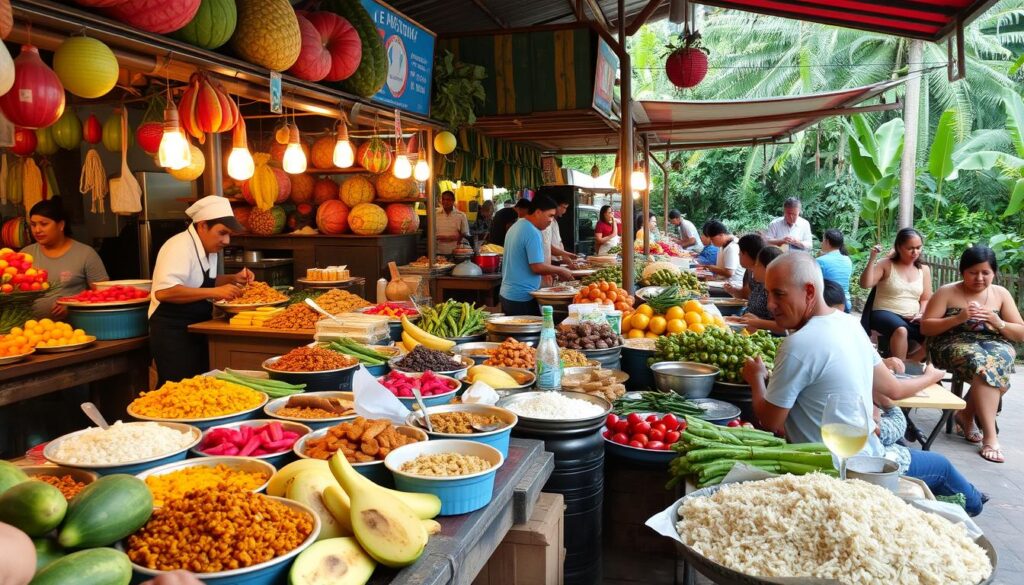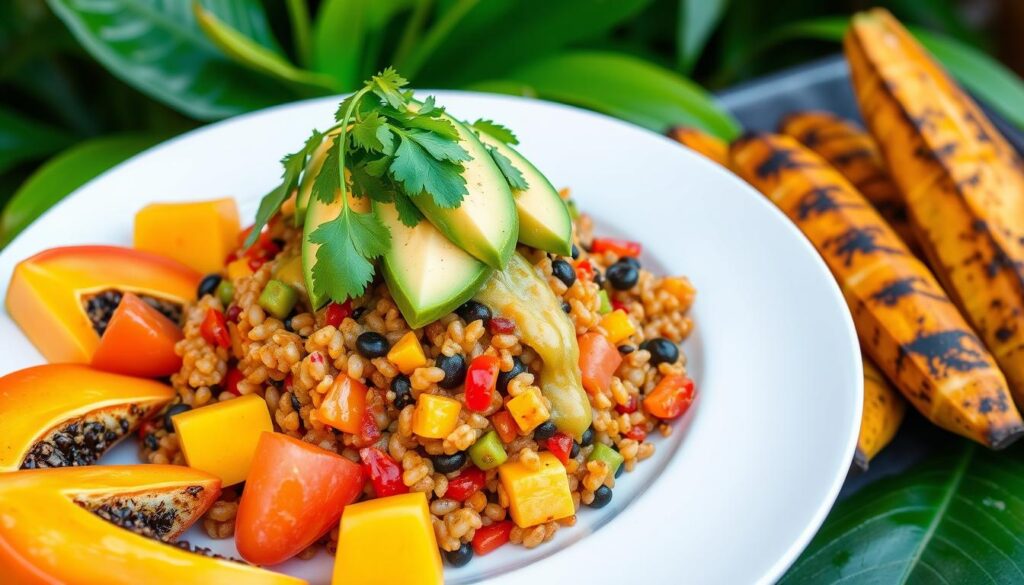Table of Contents
Costa Rican cuisine is a mix of indigenous, Spanish, and African flavors. It uses staples like rice, beans, and corn. Tropical fruits and spices add bold tastes, showing the country’s rich culture.
Trying costa rica food is more than just eating. It’s about community, tradition, and joy. The focus on fresh, local ingredients and traditional cooking makes it a treat for the senses. Whether you try classic dishes or modern twists, the flavors will impress you.
Key Takeaways
- Costa Rican cuisine is a unique fusion of indigenous, Spanish, and African influences
- Staple ingredients like rice, beans, and corn are staples of costa rica food
- Traditional dishes of costa rica are a reflection of the country’s rich cultural heritage
- Authentic costa rican cuisine emphasizes fresh, local ingredients and traditional cooking methods
- Costa rica food is not just about sustenance, but about community, tradition, and celebration
- Modern fusion cuisine is a growing trend in Costa Rican cuisine
- Exploring costa rica food is a great way to experience the country’s culture and traditions
Understanding Costa Rican Food Culture and Traditions
Exploring Costa Rican food culture reveals a rich mix of flavors and traditions. The cuisine reflects the country’s history, geography, and cultural influences. Mealtimes are special, bringing families and friends together.
Costa Rican dishes focus on fresh, local ingredients. You’ll find cilantro, garlic, and chili peppers adding flavor to many dishes. From simple gallo pinto to complex stews, each dish shares a piece of the country’s story.
The Role of Food in Costa Rican Society
Food is key in Costa Rican society, uniting people and building community. Mealtimes are for sharing stories and making memories. The traditional dishes reflect the country’s rich heritage, blending history, geography, and culture.
Traditional Cooking Methods
Costa Rican cooking often involves grilling, stewing, and sautéing. These methods highlight the natural flavors of ingredients. They also showcase the country’s cultural heritage, with many dishes passed down through generations.
| Traditional Dish | Ingredients | Cooking Method |
|---|---|---|
| Gallo Pinto | Rice, Beans, Onions, Garlic | Sautéing |
| Casado | Rice, Beans, Meat, Vegetables | Grilling |
| Empanadas | Meat, Onions, Garlic, Pastry | Baking |
Essential Costa Rica Food You Must Try
When you visit Costa Rica, you’ll find many amazing places to eat. These spots offer a variety of tasty dishes. From gallo pinto to fresh seafood, you’ll love every bite. For the best experience, check out a Costa Rican food blog for tips and recommendations.
Some dishes you must try include:
- Casados: a traditional plate with rice, beans, meat, and vegetables
- Empanadas: pastry pockets filled with meat, cheese, or vegetables
- Ceviche: fresh seafood marinated in lime juice
Don’t forget to try coconut water or a cold beer. You can find these and more at the best places to eat in Costa Rica. From casual spots to fancy restaurants, there’s something for everyone. Also, explore the popular Costa Rican recipes and cooking methods to enjoy the flavors at home.
Costa Rica’s food scene is diverse and vibrant. It showcases the country’s rich flavors and traditions. Whether you’re a food lover or just looking to try new things, you’ll be amazed by the best places to eat in Costa Rica and the popular recipes.
| Dish | Description | Price |
|---|---|---|
| Casados | Traditional plate with rice, beans, meat, and vegetables | $10-$15 |
| Empanadas | Pastries filled with meat, cheese, or vegetables | $5-$10 |
| Ceviche | Fresh seafood marinated in lime juice | $15-$20 |
The Heart of Costa Rican Breakfast: Gallo Pinto
Gallo pinto is a key part of costa rican food. It’s a mix of fried rice, beans, and eggs. This makes it a hearty and tasty breakfast.
To make real gallo pinto, start with rice, beans, onions, and garlic. Then, add your favorite touches like cheese or hot sauce.
Regional Variations and Serving Suggestions
Gallo pinto is very flexible. You can make it spicy or mild, depending on what you like. Here are some popular ways to enjoy it:
- Gallo pinto with sausage or bacon for added protein
- Gallo pinto with scrambled eggs or fried eggs on top
- Gallo pinto with a side of tortillas or toast for a filling breakfast
Gallo pinto is a must-try for those interested in costa rican food. It’s a true taste of costa rican cuisine. So, why not give it a try and see for yourself?
Popular Main Dishes and Their Cultural Significance
Exploring costa rican food culture reveals a variety of traditional dishes. These dishes show the country’s rich cultural background. Costa rican cuisine blends Spanish, African, and indigenous flavors, creating a unique taste.
Popular dishes like casados, olla de carne, and arroz con pollo are favorites. They are made with local ingredients like plantains, yuca, and beans. This adds to their cultural value. You can taste the real costa rican cuisine by trying these dishes at local spots or cooking them yourself.
Here are some key ingredients and dishes to try:
- Casados: a traditional dish made with rice, beans, meat, and vegetables
- Olla de carne: a hearty beef stew cooked in a clay pot
- Arroz con pollo: a flavorful chicken and rice dish

Exploring costa rican food culture and trying these dishes helps you understand the country’s history and culture. The mix of flavors and ingredients in costa rican cuisine shows the country’s diverse cultural roots. It’s a fascinating and tasty journey for food lovers and travelers.
| Dish | Ingredients | Cultural Significance |
|---|---|---|
| Casados | Rice, beans, meat, vegetables | Traditional family dish |
| Olla de carne | Beef, vegetables, clay pot | Hearty stew for special occasions |
| Arroz con pollo | Chicken, rice, spices | Flavorful dish for everyday meals |
Fresh Tropical Fruits and Local Beverages
Exploring costa rican food reveals a world of fresh tropical fruits and local drinks. You’ll find mangoes and pineapples with sweet and tangy flavors. Coconut water and fresh juices add to the delight of traditional dishes.
Start by visiting a local fruit market to try new flavors. You’ll find exotic fruits like guanabana, mangosteen, and passionfruit. These fruits are not only tasty but also full of nutrients, often used in costa rican recipes.
Seasonal Fruit Guide
- Mangoes: available from May to October
- Pineapples: available year-round
- Coconuts: available year-round
Traditional Drink Recipes
Popular drinks include fresh coconut water, pineapple juice, and mango smoothies. These are refreshing and show the best of costa rican cuisine.
Street Food Adventures in Costa Rica
Exploring Costa Rica’s streets reveals a world of tastes and smells. From San José’s markets to Tamarindo’s beachside stalls, costa rican street food is a must-try. Knowing the best places to eat in costa rica and popular costa rican recipes is key to a great street food adventure.
Don’t miss out on empanadas, tacos, and ceviche. These dishes are found at popular spots like Mercado Central in San José. For a real taste of Costa Rica, try local favorites like casados and arroz con pollo.
Popular Street Food Vendors
- Mercado Central in San José
- Beachside food stalls in Tamarindo
- Street food vendors in Puerto Viejo
Safety Tips for Street Food Dining
To enjoy street food safely, follow some simple rules. Pick vendors loved by locals and choose stalls with lots of customers. This way, you can safely explore the costa rican street food scene and find the best places to eat in costa rica and try the popular costa rican recipes.
| Street Food | Location | Price |
|---|---|---|
| Empanadas | Mercado Central | $5 |
| Tacos | Beachside food stalls | $7 |
| Ceviche | Street food vendors | $10 |
Regional Specialties Across the Country
Exploring Costa Rica, you’ll find a rich costa rican food culture. Each region, from the Caribbean to the Pacific, has its own flavors and ingredients. These reflect the country’s diverse geography and culture.
The Caribbean coast mixes African, Spanish, and indigenous tastes in its costa rican cuisine. Its spicy dishes come from a history of trade and cultural exchange. You’ll enjoy rice and beans, stewed chicken, and fried plantains here.
The Pacific coast, on the other hand, is famous for its fresh seafood. Its costa rican food culture values simplicity and freshness. Try ceviche, grilled fish, and seafood stews, all made with the ocean’s bounty.
- Gallo pinto, a traditional breakfast dish made with rice and beans
- Empanadas, pastry pockets filled with meat, cheese, or vegetables
- Casados, a hearty dish made with rice, beans, meat, and vegetables
These dishes show the heart of Costa Rica’s costa rican food culture. They highlight the importance of community, family, and traditional cooking.
Modern Costa Rican Fusion Cuisine
Exploring costa rican food reveals a mix of old and new. Chefs blend traditional dishes with fresh twists. This fusion comes from using local ingredients and adding global flavors.
In San José, you’ll find restaurants that highlight this modern cuisine. They mix traditional Costa Rican dishes with international tastes. This creates a dining experience you won’t forget.

Innovative Chefs and Their Creations
Costa Rica’s top chefs are making traditional food exciting again. They use fresh ingredients and new techniques. This results in dishes like seafood paella and empanadas with unique fillings.
For a taste of modern Costa Rican cuisine, check out the country’s best restaurants. They offer a creative twist on traditional dishes. You’ll enjoy a culinary journey that will make you crave more.
Dining Etiquette and Cultural Tips
Exploring the costa rican food culture means knowing local dining rules. In Costa Rica, meals are for bonding with family and friends. The traditional dishes of costa rica are key in this. From San José’s fancy restaurants to coastal casual spots, costa rican cuisine shows the country’s warm welcome and rich culture.
To get the most out of dining here, follow these tips:
- Arrive on time for meals, as punctuality is valued in Costa Rican culture.
- Use formal titles such as “señor” or “señora” when addressing older individuals or those in positions of authority.
- Keep your hands visible on the table, as keeping them in your lap may be seen as rude.
Costa rican food culture also values community and sharing meals. When eating out, try local favorites like gallo pinto or casados. By diving into the costa rican cuisine and etiquette, you’ll truly experience the country’s lively culture.
| Restaurant Customs | Tipping Guidelines |
|---|---|
| Formal restaurants: dress code may apply | 10% to 15% of the total bill |
| Casual eateries: casual dress code | 5% to 10% of the total bill |
Where to Find Authentic Costa Rica Food
Exploring Costa Rica’s food scene is exciting. You’ll find a mix of local restaurants, food markets, and street food. Places like San José, Tamarindo, and Puerto Viejo are great for trying authentic dishes.
Local eateries serve traditional dishes like gallo pinto and empanadas. For cooking at home, check out Costa Rican food blogs. The Costa Rican Cook and Tico Times are great resources.
Here are some tips for your food adventure:
- Visit local markets, like the Mercado Central in San José, for fresh produce and snacks.
- Try street food, like tacos and ceviche, for a taste of local flavors.
- Explore regional specialties, such as seafood from the coast and stews from the mountains.
By following these tips, you’ll discover Costa Rica’s authentic flavors. Whether you’re a food lover or just curious, you’ll find something delicious. Costa Rica’s food culture is vibrant and waiting to be explored.
| Destination | Cuisine | Recommended Dish |
|---|---|---|
| San José | Traditional Costa Rican | Gallo pinto |
| Tamarindo | Seafood | Ceviche |
| Puerto Viejo | Caribbean-inspired | Jerk chicken |
Sustainable and Farm-to-Table Dining Experiences
Exploring costa rican food shows a big focus on being green and using local ingredients. This method makes sure the food is fresh and supports local farmers. It also helps the environment by cutting down on food production’s harm.
There are many ways to enjoy sustainable dining in Costa Rica. You can visit organic farms, go on food tours, or eat at eco-lodges. These places let you meet the local community, learn about farming, and taste amazing, locally made meals.
Choosing sustainable dining helps Costa Rica keep its environment safe. It also lets you dive deep into the local culture and food. This makes your meals unforgettable and fun.
Organic Farms and Food Tours
- Visit organic farms in the Central Valley to learn about sustainable farming practices and sample fresh, locally grown produce.
- Take a food tour to explore the local cuisine and meet the people behind the scenes, from farmers to chefs.
- Dine at eco-lodges that showcase traditional dishes of costa rica and support local conservation efforts.
Environmental Impact of Local Cuisine
Thinking about the environment is key when trying costa rican food. By picking sustainable and farm-to-table options, you help Costa Rica stay green. This keeps the country’s beauty alive for future generations.
| Sustainable Dining Option | Environmental Impact |
|---|---|
| Organic Farms | Reduced use of pesticides and fertilizers, promoting soil health and biodiversity. |
| Food Tours | Supporting local farmers and reducing food transportation emissions. |
| Eco-Lodges | Promoting conservation efforts and reducing waste through sustainable practices. |
Conclusion
Starting your food journey in Costa Rica opens up a world of flavors. You’ll find a mix of Caribbean spices and fresh Pacific seafood. This mix creates a culinary experience that will stay with you.
Look for local markets, street food, and farm-to-table spots to taste the real Costa Rica. Talk to the locals, learn about their food traditions, and try new ingredients and cooking methods. This will help you understand what makes their food special.
Trying dishes like gallo pinto, tropical fruits, and new fusion foods will make your trip even better. It will also deepen your love for Costa Rica’s food culture. Enjoy the vibrant flavors, smells, and community spirit that define Costa Rican cuisine.
FAQ
What are the most popular traditional dishes in Costa Rica?
In Costa Rica, you’ll find favorites like gallo pinto (rice and beans) and casado (a mix of rice, beans, plantains, and a protein). Olla de carne (beef stew) and arroz con pollo (chicken and rice) are also loved.
What are the common ingredients used in Costa Rican cuisine?
Costa Rican dishes often include rice, beans, corn, and plantains. You’ll also find yuca, cilantro, garlic, and chili peppers. Fresh tropical fruits like pineapple, mango, and coconut are common too.
Where can I find the best street food in Costa Rica?
For amazing street food, check out San José’s markets, Tamarindo’s beach stalls, and food trucks across the country. Try empanadas, tacos, ceviche, and fresco (fresh fruit juices).
How can I experience authentic Costa Rican cuisine?
To taste real Costa Rican food, look for local restaurants, markets, and family spots. Food tours and cooking classes are also great ways to dive into the culinary traditions.
What are the regional specialties in Costa Rica?
Costa Rica’s cuisine varies by region. The Caribbean coast is known for spicy dishes, the Pacific coast for fresh seafood, and the Central Valley for hearty stews. Try Caribbean-style rice and beans, ceviche, and tamales.
Can I find vegetarian or vegan options in Costa Rican cuisine?
Yes, Costa Rica offers many vegetarian and vegan choices, mainly in cities and tourist spots. Traditional dishes can often be made plant-based, and there are many vegetarian-friendly places to eat.
How do I properly tip for meals in Costa Rica?
In Costa Rica, tip 10% for sit-down meals. But, some places might already have a service charge, so check the bill first.
Where can I find the best fruit markets in Costa Rica?
For top fruit markets, visit the Central Market (Mercado Central) in San José and local farmers’ markets. Roadside stands are also great for fresh tropical fruits.

